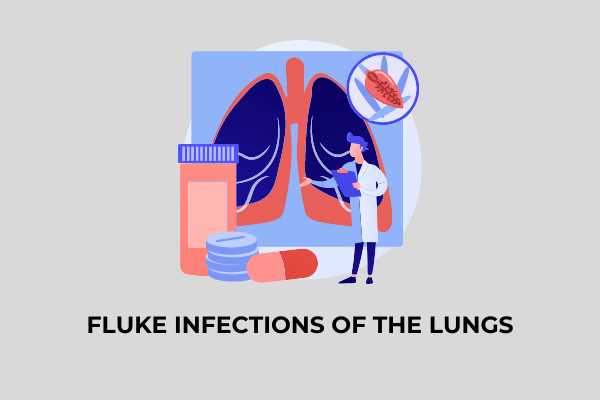People to be infected by lung fluke when eating freshwater crabs or crayfish? What are the symptoms of paragonimus infection according to the guidelines of the Ministry of Health in Vietnam?
- What are the causes of paragonimus infection according to the guidelines of the Ministry of Health in Vietnam?
- What are the symptoms of paragonimus infection according to the guidelines of the Ministry of Health in Vietnam?
- What is the life cycle of lung fluke according to the guidelines of the Ministry of Health in Vietnam?
What are the causes of paragonimus infection according to the guidelines of the Ministry of Health in Vietnam?
Pursuant to Section 1 of the Guidelines issued together with Decision 1573/QD-BYT in 2022 of the Ministry of Health, there are the following guidelines on paragonimus infection:
"1. GENERAL OBJECTIVES
Paragonimus infection are caused by a fluke of the genus Paragonimus that lives in the lungs or pleura. People are infected by containing fluke larvae in raw or undercooked freshwater crabs or crayfish.
1.1. Agent
- Worldwide, more than 40 species of lung flukes of the genus Paragonimus have been reported to infect animals and humans. Of the more than 10 species reported to infect humans, the most common is P. westermani.
- Currently, in Vietnam, only P. heterotremus species infection in humans has been detected.
- Paragonimus infections are common in some provinces such as Lai Chau, Son La, Hoa Binh, Lao Cai, Yen Bai, Ha Giang, Lang Son, Tuyen Quang, Phu Tho, Nghe An.
1.2. Inoculum
Wild animals such as mink, fox, civet, tiger, leopard... are infected with lung fluke. Freshwater crabs or crayfish contain lung fluke larvae.
1.3. Infectiousness and immunity"
Everyone can be infected by paragonimus infections. After being infected with lung fluke larvae 5-6 weeks, people will appear with specific antibodies in the blood.
Accordingly, people can be infected by paragonimus infections by eating undercooked freshwater crabs or crayfish containing lung fluke larvae. Wild animals are also susceptible to lung fluke infections and the infection is often distributed in some localities such as Lai Chau, So La, Ha Giang, etc.
In addition, everyone, regardless of sex or age, can be infected by lung fluke. Therefore, people should not be careless in the prevention of paragonimus infections.

People to be infected by lung fluke when eating freshwater crabs or crayfish? What are the symptoms of paragonimus infections according to the guidelines of the Ministry of Health in Vietnam?
What are the symptoms of paragonimus infection according to the guidelines of the Ministry of Health in Vietnam?
Pursuant to Section 2 of the Guidelines promulgated together with Decision 1573/QD-BYT in 2022 of the Ministry of Health, there are guidelines for recognizing paragonimus infections through the following clinical symptoms:
The main symptoms of paragonimus infections:
+ Cough lasts many months, many years; progression of acute episodes. Cough and sputum bloody sputum (usually a little mixed with sputum, bright red, or dark red, or rust in color, sometimes coughing up a lot of fresh blood at once depending on the damage to the blood vessels where the parasites are in the bronchus)
+ Fever: in most cases there is no fever, no infection, and little collapse.
+There may be chest tightness, difficulty breathing.
+ There may be wheezing sounds inside the lungs.
+ There is reduction syndrome 3 at the bottom of the lung when there is pleural effusion (if flukes are in the pleura, they cause pleural effusion).
- In cases the fluke is located in other viscera, the clinical symptoms shall be complicated, depending on the parasitic viscera. If the fluke is in the brain, there are often symptoms of epilepsy, the liver fluke causes liver abscess...
Thus, people infected by lung fluke will suffer from coughs that last for several months or years, cough and sputum with blood, most patients with lung flukes will not show symptoms of fever. In case of brain fluke, there will be epileptic symptoms in the patient.
What is the life cycle of lung fluke according to the guidelines of the Ministry of Health in Vietnam?
Pursuant to Section 1 of the Guidelines issued together with Decision 1573/QD-BYT in 2022 of the Ministry of Health, guiding the life cycle of lung fluke is as follows:
(1) Lung flukes lay eggs. Eggs are excreted in sputum or stool of infected people, fall into the water.
(2) In the environment, the eggs develop, hatch into an immature form (called miracidia),
(3) Miracidia are ingested by snails, develop into a form that can swim (cercariae).
(4) The cercariae infect crabs or crayfish and form cysts (called metacercariae).
(5) People (or animals) are infected when they swallow cysts in raw, undercooked, or pickled freshwater crabs or crayfish; In the intestine, the larvae leave the cyst. The larvae penetrate the wall of the intestine, pass through the diaphragm, and invade the lungs.
(6) There, they develop into adults and produce eggs in about 5-6 weeks, which are passed in sputum that is coughed up and spit out or swallowed and passed in stool.
Accordingly, Lung flukes lay eggs. Eggs are excreted in sputum or stool of infected people, fall into the water. In the environment, the eggs develop, hatch into an immature form (called miracidia). Miracidia are ingested by snails, develop into a form that can swim (cercariae). The cercariae infect crabs or crayfish and form cysts (called metacercariae). People (or animals) are infected when they swallow cysts in raw, undercooked, or pickled freshwater crabs or crayfish; In the intestine, the larvae leave the cyst. The larvae penetrate the wall of the intestine, pass through the diaphragm, and invade the lungs. There, they develop into adults and produce eggs in about 5-6 weeks, which are passed in sputum that is coughed up and spit out or swallowed and passed in stool.
Above are some symptoms and life cycle of lung fluke that people need to pay attention to!
LawNet
